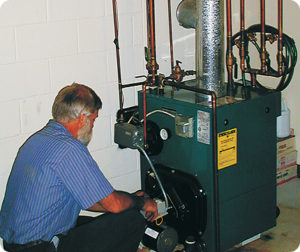 Your oil burning furnace ought to run like the well-oiled machine it is. However, things do happen and at times it doesn’t function as required. An oil furnace works just like a blowtorch in a fireproof box. The electrical ignition sparks a high pressure mist of air and oil causing the air in the adjustable chamber to become heated. A blower then pushes the warmth and spreads it around your home. Though complex in structure, an oil furnace doesn’t normally experience problems. When start seeing problems you cannot understand; the best step is to call a HVAC professional.
Your oil burning furnace ought to run like the well-oiled machine it is. However, things do happen and at times it doesn’t function as required. An oil furnace works just like a blowtorch in a fireproof box. The electrical ignition sparks a high pressure mist of air and oil causing the air in the adjustable chamber to become heated. A blower then pushes the warmth and spreads it around your home. Though complex in structure, an oil furnace doesn’t normally experience problems. When start seeing problems you cannot understand; the best step is to call a HVAC professional.
Inspect the Thermostat
The oil furnace thermostat just like the other thermostats can prevent the effective heating of your home. Ensure the fan mode is set to automatic and the thermostat is set to heat.
Check Your Oil Supply
Many homeowners rely on the gauge indications. While it is meant to be working effectively, the gauge can at times fail because it is just like any other component. This is when you have to roll your sleeves and physically check the fuel tank. A dipstick can help you determine the quantity of fuel that you have. Remember that the fuel level must not get low because this can make the sludge and sediment to get sacked into the lines and plug up filters.
Inspect the Furnace
Check whether you can hear the furnace running or the warmth of the cabinet when you touch it. The air filter may be so dirty thereby blocking the airflow. Remove the filter and replace it to see whether this sorts the problem.
Check the Reset Button
If the furnace fan is running well and the circuit is okay, the next place to check is the reset button located on the furnace control module. If the button is popped up, the problem could be fuel related. Lack of enough fuel or obstruction to fuel flow can be a potential problem. Try pressing the reset button and check your inline filter and oil tank.
Troubleshoot Unusual Sounds
Strange sounds such as knocking sounds, clattering sounds and squealing sounds may portend a problem within the unit. When you hear knocking sounds, chances are air has gotten into the lines. To solve this, you should purge the air. Clattering sounds indicate loose components within the furnace. You can solve this by simply checking the access panels. Squealing sounds on the other hand are normally associated with the blower motor or belt. You can simply shut the furnace down and inspect the belt. Try putting a few drops of electric motor oil on the ports located on the firing assembly fan. This should solve the problem.
Some of the problems are simple to fix, but others may require the attention of a professional. Don’t hesitate to call when the issue spirals beyond your understanding.




